Research on the compensation mechanism of pressure compensating emitters based on numerical simulation and visualisation experiment
IF 4.4
1区 农林科学
Q1 AGRICULTURAL ENGINEERING
引用次数: 0
Abstract
Pressure compensating (PC) emitters can maintain a stable flow rate within a large pressure range, which can better meet the needs of efficient water-saving irrigation technology. The basis for designing high-performance PC emitters is clarifying their working principles. Numerical simulation and visualisation experiments were combined to study the compensation mechanism of PC emitters. Based on the visualisation experimental sample, a simulation model of a PC emitter was established for fluid–solid coupling calculation of its working process. The correctness of the numerical simulation was verified through hydraulic performance experiments and elastic diaphragm deformation visualisation experiments. A detailed analysis was conducted on the pressure drop characteristics, fluid velocity variation characteristics, elastic diaphragm deformation characteristics, and fluid-structure interaction characteristics of the PC emitter. A constant flow rate state model of the PC emitter was established. The maximum error between the numerical simulation results and the experimental results did not exceed 12 %. The results indicate that only when the energy consumption of the labyrinth channel remained constant and the energy consumption of the PC chamber increased linearly with the working pressure, could the flow rate of the PC emitters remain constant. The energy consumption capacity of the PC chamber determines when the energy consumption of the labyrinth channel changes from an increasing state to a stable state. The factors that determine the deformation characteristics of the elastic diaphragm affect the performance of the PC emitter.
基于数值模拟和可视化实验的压力补偿发射器补偿机理研究
压力补偿型(PC)灌水器可以在较大的压力范围内保持稳定的流量,能够较好地满足高效节水灌溉技术的需要。设计高性能PC发射器的基础是明确其工作原理。采用数值模拟和可视化实验相结合的方法,研究了PC辐射源的补偿机理。以可视化实验样品为基础,建立了PC发射极的仿真模型,对其工作过程进行了流固耦合计算。通过水力性能实验和弹性膜片变形可视化实验验证了数值模拟的正确性。详细分析了PC发射器的压降特性、流体速度变化特性、弹性膜片变形特性和流固耦合特性。建立了PC发射极的等流量状态模型。数值模拟结果与实验结果的最大误差不超过12%。结果表明,只有迷宫通道的能量消耗保持不变,PC腔室的能量消耗随工作压力线性增加时,PC发射器的流量才能保持不变。PC腔室的能量消耗能力决定了迷宫通道的能量消耗何时从增加状态转变为稳定状态。决定弹性膜片变形特性的因素影响着PC发射极的性能。
本文章由计算机程序翻译,如有差异,请以英文原文为准。
求助全文
约1分钟内获得全文
求助全文
来源期刊

Biosystems Engineering
农林科学-农业工程
CiteScore
10.60
自引率
7.80%
发文量
239
审稿时长
53 days
期刊介绍:
Biosystems Engineering publishes research in engineering and the physical sciences that represent advances in understanding or modelling of the performance of biological systems for sustainable developments in land use and the environment, agriculture and amenity, bioproduction processes and the food chain. The subject matter of the journal reflects the wide range and interdisciplinary nature of research in engineering for biological systems.
 求助内容:
求助内容: 应助结果提醒方式:
应助结果提醒方式:


